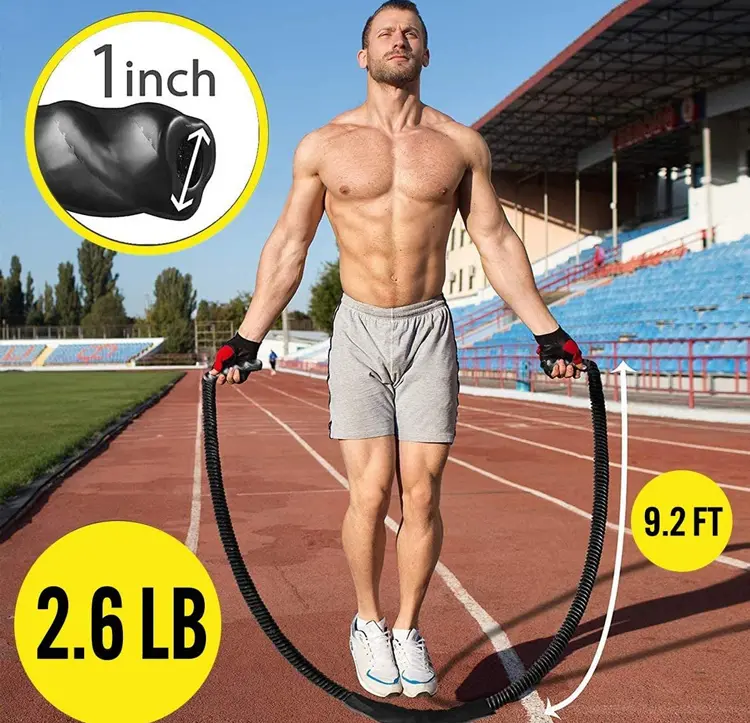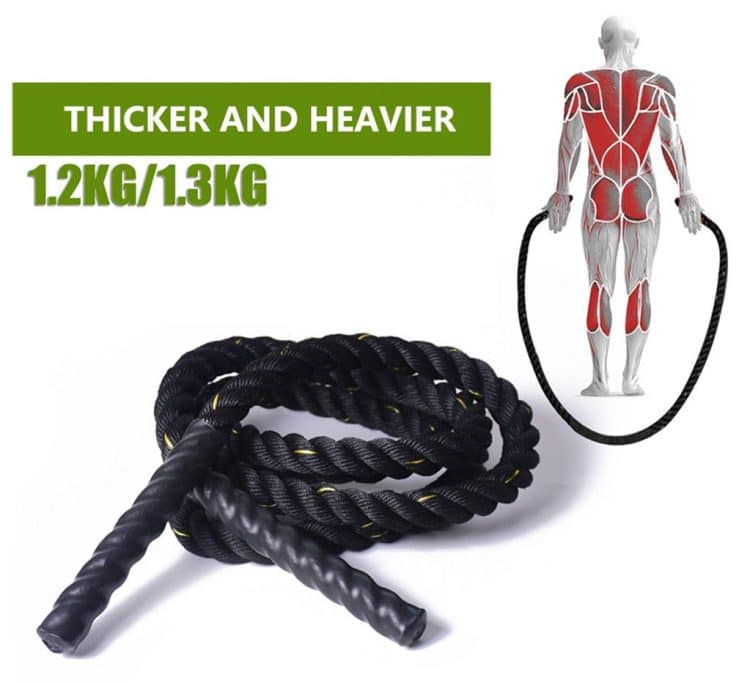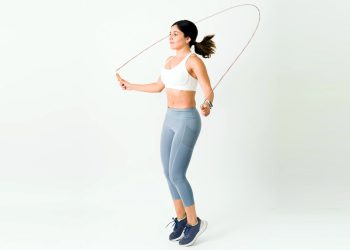Whatever your training goal, cardio should be part of your workouts. Cardio workouts can help you get and stay lean, improve your fitness, and keep you healthy. Bodybuilders, powerlifters, Olympic weightlifters, and strongman competitors should all include cardio in their weekly training schedules.
But let’s be honest, most people reading this article would rather be lifting than running, cycling, or doing Zumba. After all, it’s squats, deadlifts, and bench presses that make you buff and not sweating over an exercise bike console.
So, what if we told you there was a type of cardio that could increase muscle size and strength and fits easily around your weight-training workouts? In fact, you can do it at home!
In this article, we discuss the benefits of weighted jump rope training, tell you how to do it, and give you a few tried-and-tested workouts to try.
What is a Weighted Jump Rope?
Jump ropes are often very thin and light. They spin fast and don’t require a lot of effort to use. Sure, they deliver a great workout, but you need to push the speed and use them for quite a long time to burn many calories or challenge your fitness.
Tricks like double-unders and high knees will make your workout more intense, but those skills take time to learn, and frankly, not everyone has the athleticism to pull them off. If you spend more time tripping on your rope than jumping over it, your workout will soon become a source of frustration.
Level Up Your Fitness: Join our 💪 strong community in Fitness Volt Newsletter. Get daily inspiration, expert-backed workouts, nutrition tips, the latest in strength sports, and the support you need to reach your goals. Subscribe for free!
In contrast, a weighted rope weighs at least a quarter of a pound, and many are much heavier than this – five pounds or more. Most have thick wire ropes and may even have weighted handles. Others are made from lengths of manila rope and are basically short lengths of battle ropes.

While weighted jump ropes don’t spin as fast as speed ropes, they take a more muscular effort to use, which is what makes them so effective.
The Benefits of Weighted Jump Rope Training
In the same way that lifting heavy weights is usually better for you than lifting light weights, using a weighted rope has a few advantages over regular jump rope training.
Easier to learn
Learning to jump rope is not easy, and that’s especially true if you are using a speed rope. As the name implies, speed ropes spin quickly and with minimal effort. In addition, they’re very thin, which makes them hard to see.
Weighted jump ropes spin slower and are much thicker, which makes them more beginner friendly. If you are new to jumping rope, you’ll probably get to grips with it quicker if you start out using a weighted rope.
Increased upper-body muscle engagement
Unless you go really fast, you won’t need to use much effort to get a speed rope spinning. Once you get a speed rope going, momentum tends to take over.
In contrast, weighted ropes take a lot more muscular force to start and then keep them spinning. As a result, your entire upper body gets a great workout which, depending on the weight of your heavy jump rope, could lead to increased muscular endurance, strength, and even size.
The muscles trained using a weighted jump rope include:
- Deltoids (anterior, medial, and posterior)
- Pectoralis major
- Latissimus dorsi
- Trapezius (upper, middle, and lower fibers)
- Serratus anterior
- Biceps
- Triceps
- Forearms
In addition, your legs also get a great workout, although you probably won’t experience much in the way of strength or muscle gains, even with a heavy rope.
The deltoid workout from hell!
While jumping a weighted rope works all your major upper body muscles, it’s your deltoids or shoulders that end up doing most of the work. In fact, you’ll probably find that this is the muscle group you feel working the hardest.
Using a weighted jump rope will quickly leave your deltoids pumped and burning, and a couple of sets will make you feel like you’ve had a full-on shoulder workout.
More muscular forearms and a better grip
A spinning weighted rope creates a lot of torque in your wrists, and you’ll need to use your forearms to prevent the handles from being pulled out of your hands. This trains your forearms in a unique way, as they have to work with a circular action. So, as well as beefing up your shoulders, jumping a weighted rope will also develop your forearms and grip.
Burn more calories in less time
Jumping rope is a great calorie burner and can help you get and stay lean. Because you can do it at home, you can jump rope whenever it’s convenient, and you won’t need to waste your valuable gym time doing cardio.
The number of calories burned jumping rope depends on several factors, including your body weight, gender, and how fast you go. However, it’s safe to say that using a heavy rope will increase your caloric expenditure significantly.
While you won’t be able to spin a weighted rope as fast, it will require much more effort, which means you can burn more calories per workout.
Time is precious, and there is no need to waste it on unproductive workouts. Switching from a regular to a weighted jump rope means you’ll burn more calories per minute and won’t need to spend as long working out.
Shorter workouts
A little weighted rope training goes a very long way. Because of the extra effort required to spin a heavy rope, you won’t want or need to do lengthy workouts. In fact, 10-20 minutes of weighted rope training is probably all you need – even if you are an experienced rope jumper.
Improve your speed rope performance
Going from a weighted rope to a speed rope makes the latter feel much easier, and you should find that you can turn your rope far faster than before. This may be useful if you are a competitive CrossFitter, where some of the workouts involve jumping rope against the clock.
This is like doing heavy bench presses and then switching to push-ups. The strength you build on the bench press makes push-ups feel much easier.
In addition, just like regular jump rope training, using a weighted rope will:
- Build cardiovascular fitness
- Improve your speed and agility
- Build your calves and strengthen your ankles
- Improve hand-eye-foot coordination
Weighted Jump Rope Drawbacks
Weighted jump rope is very compatible with strength training. It can help you get fit and lean without spending hours at the gym doing cardio. However, there are a couple of drawbacks to consider:
Weighted jump ropes are less suitable for skills and tricks
Weighted jump ropes are generally stiffer and slower than speed ropes, so they’re not so good for tricks like crossovers, double-unders, and sideswipes. In fact, you’ll be mostly limited to two-footed bounces, boxer-style, and jogging-type moves.
If you like to do freestyle jump rope, you may find using a weighted jump rope somewhat limiting in terms of workout creativity. You may even find using a weighted rope becomes boring after a few minutes, as you won’t be able to mix things up by doing a few tricks.
Level Up Your Fitness: Join our 💪 strong community in Fitness Volt Newsletter. Get daily inspiration, expert-backed workouts, nutrition tips, the latest in strength sports, and the support you need to reach your goals. Subscribe for free!
Local muscular fatigue
As mentioned, spinning a weighted rope takes more muscular engagement than a speed rope. You may even find that your shoulders tire very quickly, bringing your workout to a premature end.
Your muscles will soon get used to the added workload. Still, initially, at least, you may find that local muscular fatigue means you can only do weighted jump rope training for relatively short periods. The best solution to this problem is to do interval training.
Noise
Lightweight speed ropes are very quiet to use, and you’ll probably only be able to hear the rope slicing through the air and tick-tick-ticking off the floor. A heavy rope, especially one made from braided metal wire, makes much more noise when it hits the deck.
This may be a drawback if you plan on using your weighted jump rope in an apartment or without bothering your housemates.
Cost
Speed ropes are very cheap, and you can often buy one for $10 or less. Weighted jump ropes are usually more expensive, but they also tend to be more hard-wearing. Given how effective heavy ropes are for fitness, strength, and fat loss, even a more costly rope is an excellent investment.
How to Use a Weighted Jump Rope
Using a weighted jump rope is pretty straightforward. The slower turn speed and increased thickness mean that heavy ropes are usually easier to use than speed ropes. That said, if you are new to jumping rope, follow these instructions, and you’ll soon become a jump rope master!
- Start with the rope behind you and your feet together. Bend your knees slightly and shift your weight forward onto the balls of your feet.
- Relax your shoulders and look straight ahead. Your hands should be about hip height with your arms slightly out and away from your sides. If you raise your hands much higher than this, you effectively shorten the rope and increase your likelihood of tripping.
- Swing the rope over your head and jump over as it approaches your feet. Remember to just clear it; you aren’t in a high jump competition, you know! Instead, see how close you can stay to the ground. This will allow you to jump more smoothly and reduce the impact on your feet and joints.
- Try to stick to one jump per rope turn and avoid the temptation to “double bounce” between revolutions. Double jumps make it harder to establish a smooth rhythm.
- Start with a slow, smooth tempo, and only speed up when you feel ready.
Don’t worry if you trip – this is a common problem for beginners. Just reset your rope and start again. In time, you’ll trip less and be able to jump rope for longer without interruption.
Weighted Jump Rope Workouts
While there is nothing wrong with using a heavy jump rope for a set time, such as ten minutes, that will soon get old. Try one of these tried and tested workouts to make weighted jump rope training more enjoyable.
1. Tabatas
Tabata training was invented by Japanese sports scientist Izumi Tabata. It’s a form of high-intensity interval training or HIIT for short. The premise is simple, and the workouts are short, but Tabatas are a very challenging way to train!
Method:
- Jump rope for 20 seconds as fast as possible
- Rest for 10 seconds
- Repeat for eight sets
2. Breathing pyramid
This workout starts easy but quickly gets harder. Rest periods are timed by the number of breaths you take, so you don’t need a timer or stopwatch to do it. Breath control is integral to many sports, including swimming and martial arts. This is an excellent option for anyone looking for a no-frills jump rope workout.
Method:
- Do 10 jump rope turns
- Take one deep breath
- Do 20 jump rope turns
- Take two deep breaths
- Do 30 jump rope turns
- Take three deep breaths
- Do 40 jump rope turns
- Take four deep breaths
- Do 50 jump rope turns
- Take five deep breaths
- Do 60 jump rope turns
- Take six deep breaths
- Do 70 jump rope turns
- Take seven deep breaths
- Do 80 jump rope turns
- Take eight deep breaths
- Do 90 jump rope turns
- Take nine deep breaths
- Do 100 jump rope turns
- Finished!
3. 5 x 100
This quick and dirty deltoid killer is an excellent way to train your shoulders without resorting to lifting weights. It’s simple but also very challenging. Feel free to reduce the rep count if 100 rope turns are too much for you right now.
Method:
- Do 100 heavy jump rope turns
- Rest for 60 seconds
- Repeat four more times to total five sets
4. Heavy jump rope Cindy
Cindy is a popular bodyweight CrossFit workout. It works every major muscle in your body. This variation also includes some weighted jump rope to increase calorie expenditure and add a welcome cardiovascular element to the workout.

Method:
Do ten laps of the following, starting each lap every 2nd minute. If you are VERY fit, continue for 30 minutes.
- 5 pull-ups
- 10 push-ups
- 15 air squats
- Weighted jump rope until the next two-minute point and then repeat
5. Big tunes workout
This workout forces you to jump rope at a set tempo for a predetermined period.
Put on your favorite fast-paced piece of music and jump rope in time to it. You could even change your jump rope technique during different parts of the song, such as when you hear a specific lyric or during the chorus. Line up 2-4 tunes for a longer workout.
120-140 beats per minute (BPM) is usually about right. Most music streaming platforms have mixed playlists at specified tempos that are ideal for this workout.
Weighted Jump Rope Considerations
We hope we’ve inspired you to start using a weighted jump rope. But, before you begin, take the following information into account to ensure that your workouts are as safe and enjoyable as possible:
Rope length
Your workouts will go much more smoothly if your weighted jump rope is the correct length. Stand on the middle and adjust it, so the handles just reach your armpits. Depending on your rope, this may mean pulling the ends of the rope through the handle or cutting off any excess. Follow the manufacturer’s instructions.
Surface
Weighted jump rope involves less impact than running, but it’s still a high-impact activity. If possible, avoid jumping rope on unforgiving surfaces like concrete or tarmac. Sprung wooden floors are best, and matted floors work well too.
If you HAVE to work out on a hard floor, make sure you change up your moves to avoid overloading any one part of your feet. Also, include some traveling for the same reason.
Footwear
Leading on from the point above, shock-absorbing shoes can take a lot of the pain out of weighted jump rope training. Dig out your cushioned running shoes and avoid wearing minimalist workout or weightlifting shoes.
Build up gradually
Because weighted jump rope is a high-impact activity, you should rein in your enthusiasm and avoid doing too much too soon. Lengthy heavy jump rope workouts can leave you with sore feet and shins and could even cause stress fractures. Start with short workouts and increase gradually as you become accustomed to the demands of weight jump rope training.
It’s also important to remember that heavy ropes are much harder to use than speed ropes and are available in different weights. It’s okay to start light and progress to a heavier rope after a few months of consistent training. Some ropes are even adjustable, so you can add weight as you get stronger.
Space
You can use a weighted jump rope in quite tight areas, but you still need to ensure that you have enough room around you to avoid hitting anything (or anyone) with your rope. Don’t forget to check overhead; hitting a light fixture or ceiling fan will bring your workout to an abrupt halt and could cause serious injury.
Closing Thoughts
A weighted jump rope is a great way to get fit, burn fat, and even build a stronger, more muscular upper body. Best of all, you don’t need to go to a gym to do it. In fact, you can enjoy all the benefits of this time-efficient workout in the comfort of your own home!
Heavy jump ropes are also somewhat easier to learn and master than lighter speed ropes. However, they’re not as good for skills and tricks, which is where speed ropes are best.
But if you want to get fit and burn calories as efficiently as possible, a weighted jump rope is hard to beat!










